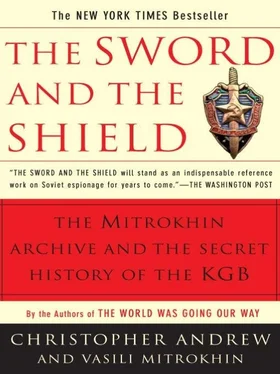In 1967 ZOLUSHKA was rewarded for her work as a KGB agent with the secret granting of Soviet citizenship. For the next four years she continued to provide classified documents and other intelligence from the British embassy and the SIS station in Beirut. In 1971, after she had been questioned about the discovery of the radio microphones, she was hurriedly exfiltrated to the Soviet Union, settled in Armenia and given a modest pension of 120 roubles. In 1978, after the Armenian KGB reported to the Centre that the pension was insufficient, Andropov approved an increase to 180 roubles.
BECAUSE OF THE closeness of Anglo-American intelligence cooperation, eavesdropping on the SIS Beirut station also produced intelligence on the CIA. The KGB discovered plans for, and was able to forestall, a joint CIA/SIS operation to bug the Beirut bureau of Novosti. 25In 1969 the KGB residency began an operation which, it was hoped, would penetrate the CIA station (codenamed OMUT (“Whirlpool”)) 26as successfully as ZOLUSHKA had penetrated that of SIS. On KGB instructions, one of its Lebanese agents, a hotel owner codenamed MARAT, founded an employment agency designed to attract maids and domestic servants who could be used in operations against the Main Adversary. The most promising applicant to the agency was Mary Matrosian (codenamed VERA), a Lebanese maid from an Armenian family living in Syria. Until 1967 she had worked in the American ambassador’s residence in Beirut, but had taken refuge with her family in Syria after the outbreak of the Arab—Israeli Six Day War. On her return to Beirut in 1969, MARAT’s agency found her domestic work with a series of American diplomatic families. VERA was recruited by MARAT under a false flag to provide information on her employers and remove papers from their homes. MARAT told her the information was needed by Armenian community and church leaders in order to keep them informed of potential threats to the security of the Armenian people. In 1971 MARAT handed her over to a controller from the Beirut residency, who posed as a fellow Armenian. With VERA’s (possibly unwitting) help, the KGB succeeded in bugging the apartment of the CIA officer for whom she worked. 27
KGB files record a number of other KGB attempts to bug CIA stations, though none seems to have been as successful as operation RUBIN. Among the most vulnerable US embassies was that in Conakry, the capital of Guinea. One of the files noted by Mitrokhin contains a brief reference to the successful bugging of an American diplomat’s apartment in Conakry in 1965. 28Much fuller details are available on the bugging of the Conakry embassy during the 1970s, when sub-Saharan Africa became for the first time a priority area for both Soviet foreign policy and KGB operations. 29In December 1972 a Guinean employee of the embassy recruited by the KGB (code-named successively RUM and SANCHO) succeeded in installing a radio-operated eavesdropping device in the office of the ambassador, Terence Todman (succeeded in May 1975 by William Harrop). RUM/SANCHO was instructed that, if detected, he was to tell his interrogators that he had been paid to place the bug by a Chinese diplomat whose visiting card he was given. The bug (replaced by an improved version in January 1974) was so well concealed, however, that it went undetected during three annual checks on embassy security. The KGB monitoring post which recorded Todman’s dictation and conversations with embassy and CIA staff (operation REBUS) was situated in an apartment only thirty meters from the ambassador’s office.
The voice-activated bug was sometimes activated by Todman’s engaging habit of bursting into song or whistling cheerfully to himself. In general, however, operation REBUS provided what the Centre considered information “of great operational value” on US policy to African liberation movements as well as on State Department assessments of Soviet-American relations and Soviet policy in Africa. The volume of intelligence was so large that two English-speaking operations officers, Anatoli Mikhaylovich Zheleznoy and Yuri Yefimovich Tatuzov, were seconded from the KGB residency in Addis Ababa to process it. In July 1975 bugged conversations in the ambassador’s office revealed that the embassy was aware there had been a leak in its communications with Washington and had asked the State Department for help in reviewing embassy security. Though strongly tempted to remove the bug, the Conakry residency decided not to do so for fear of compromising RUM/SANCHO. According to a KGB damage assessment, when the bug in the ambassador’s office was discovered in September, “suspicion fell entirely on the Guinean Special [Intelligence] Services.” RUM/SANCHO went undetected and remained on the embassy staff. 30
The KGB’s most ambitious bugging operation against a US diplomatic mission during the later Cold War was the bugging of a new eight-storey Soviet-built embassy building in Moscow on which construction began in 1979. The CIA was warned in 1980 by a defector from the Eighth Chief Directorate, Viktor Sheymov, that “the KGB was going to make the building itself a giant system of sensors that could pick up virtually anything.” Officials in Washington, however, rashly concluded that any sensor installed by the KGB could be detected and removed before it was used. Five years later they discovered they had made an expensive mistake. Further investigation revealed a series of highly sophisticated bugs built into the fabric of the building which made it, according to a member of the House Foreign Affairs Committee, “an eight-storey microphone plugged into the Politburo.” Steel-reinforcing rods set into the concrete were designed to serve as antennae. A power source, codenamed BATWING by the CIA, which was discovered embedded in a concrete wall, was estimated to be able to last for a century. One US official, interviewed by the Washington Post, commented, “Our technical people were astounded at the level of sophistication. One man from the CIA said, ‘These are the kind of things that are only on the drawing boards here.’” For the KGB as well as the State Department, however, the operation ended in expensive failure. The new embassy building was never occupied. 31
MOST EAVESDROPPING OPERATIONS using bugs planted in foreign embassies or overseas targets were short-term, unlikely to last more than a few years. By the late 1960s the FCD’s most important and long-term SIGINT operations were run by specialized posts within its residencies in foreign capitals which intercepted local telephone and radio communications. The earliest such intercept post appears to have been that set up in the Mexico City residency in 1963. Codenamed RADAR, it was given the task of intercepting the communications of the US embassy and CIA station, but had only limited success. 32The most successful of the residency posts created to intercept the communications of the Main Adversary were those set up in the United States itself. The first, codenamed POCHIN (“Start” or “Initiative”), started life in 1966 on the top floor of the Soviet embassy on Sixteenth Street in Washington, a few blocks from the White House. In 1967 a similar post, codenamed PROBA (“Test” or “Trial”), was established by the New York residency. There were eventually five POCHIN intercept posts in various Soviet establishments in and around Washington and four PROBA posts in the New York region. 33
By 1970 POCHIN-1 (at the embassy) and POCHIN-2 (in the embassy residential complex) had transformed intelligence collection by the Washington residency. 34According to Oleg Kalugin, head of Line PR:
We were able to overhear the communications of the Pentagon, the FBI, the State Department, the White House, the local police, and a host of other agencies. These communications all were broadcast on open, non-secure channels, but nevertheless a surprising amount of useful material was relayed over the airways. 35
Читать дальше











